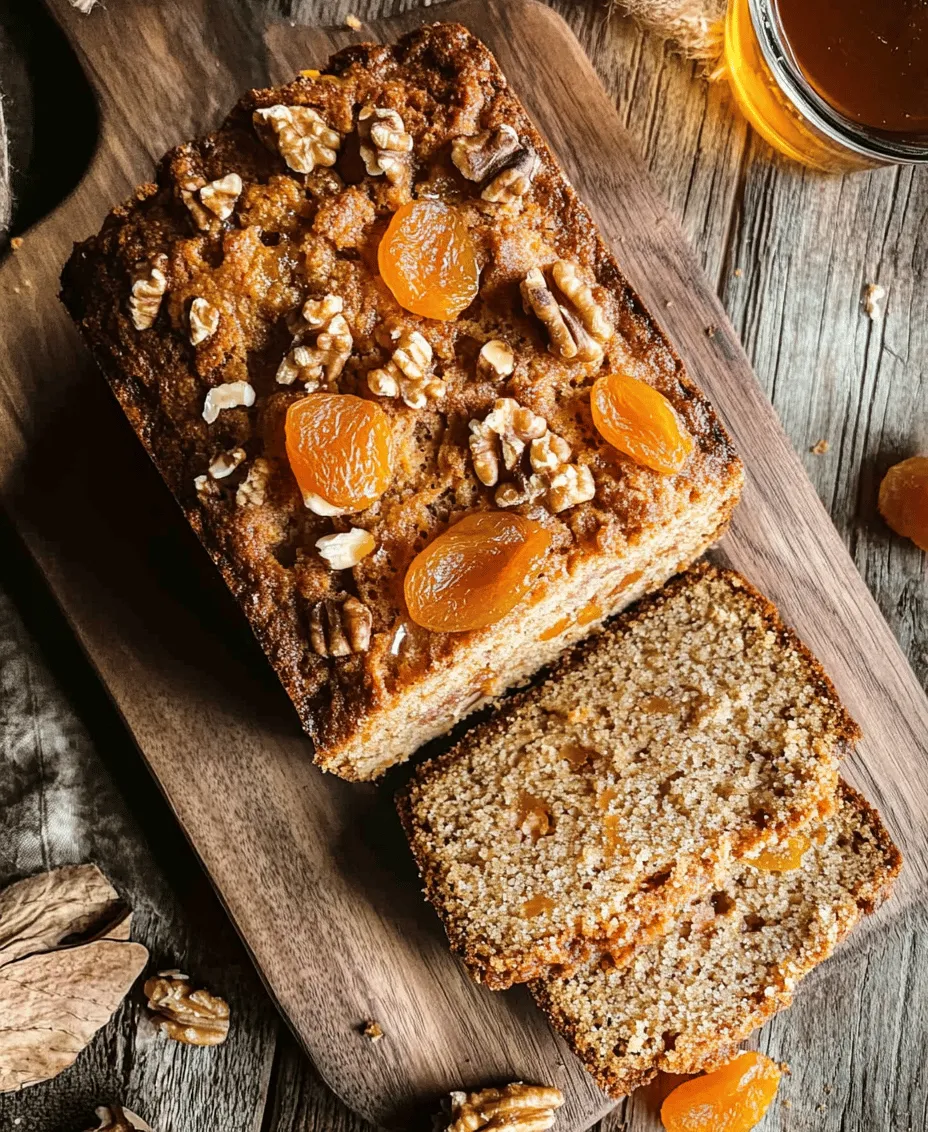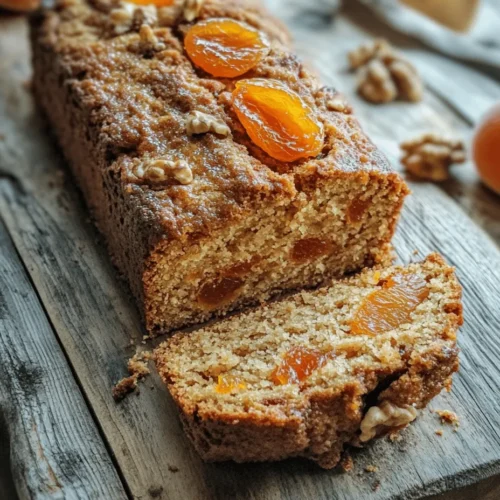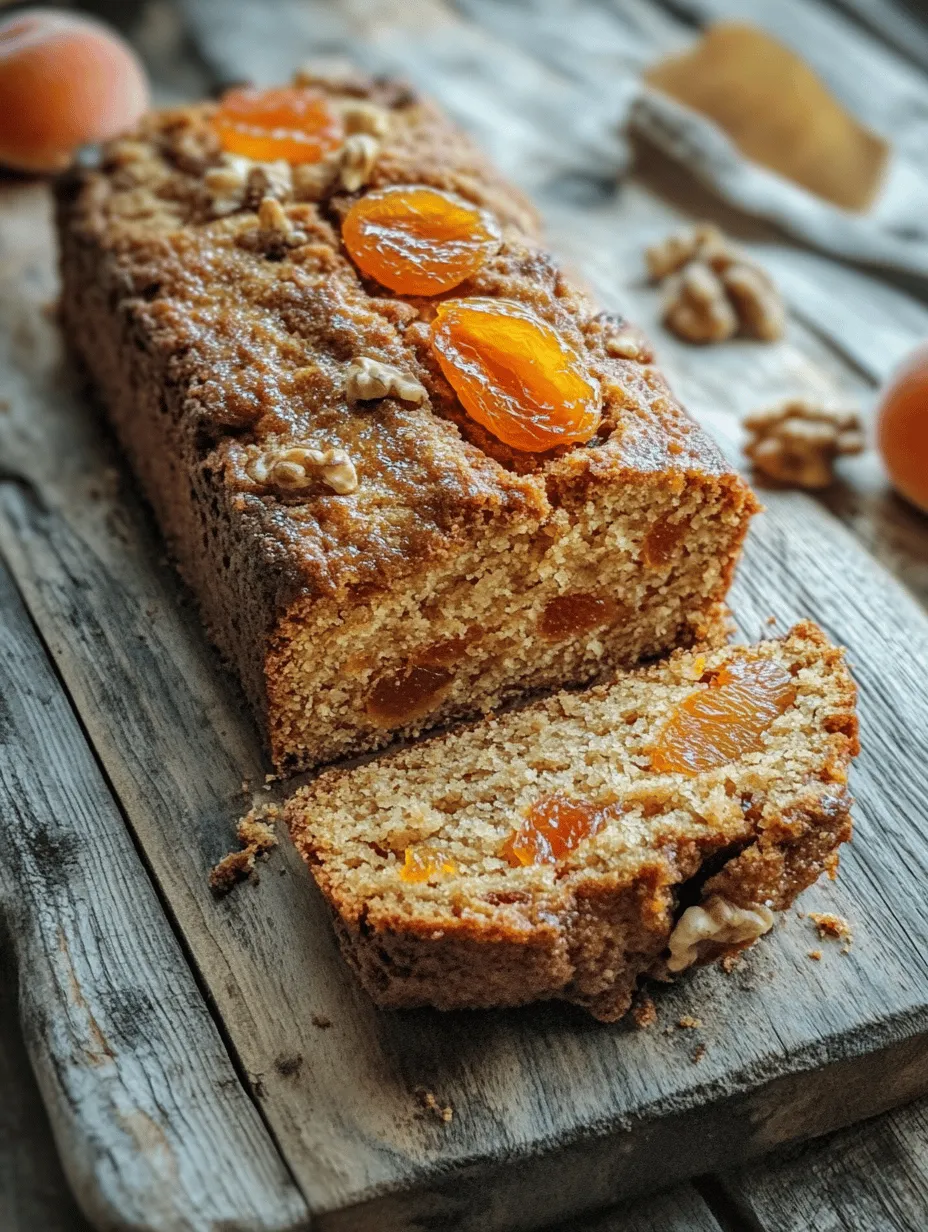Introduction to Quick & Easy Apricot and Walnut Fruitcake
Welcome to the delightful world of homemade baking, where each recipe is a journey full of flavor and creativity. Today, we’re diving into a classic that has stood the test of time—the Quick & Easy Apricot and Walnut Fruitcake. This delectable dessert is not just a cake; it’s a beautiful blend of sweet and nutty flavors that creates a moist, rich cake perfect for any occasion, be it a festive gathering, a cozy family dinner, or simply a treat for yourself.
This fruitcake stands out for its simplicity. With an easy-to-follow recipe, you don’t need to be a master baker to create this scrumptious dessert. The combination of dried apricots and crunchy walnuts brings a unique texture and taste that appeals to both young and old. Moreover, it’s a cake that invites experimentation—feel free to add your favorite fruits or nuts to personalize it.
In this article, we will explore the ingredients that make up this delightful cake, provide step-by-step instructions to guide you through the baking process, and share a bit about the history and benefits of fruitcakes. By the end, you’ll have everything you need to bake a stunning Apricot and Walnut Fruitcake that will impress anyone fortunate enough to indulge in its flavors.
Understanding the Ingredients of Apricot and Walnut Fruitcake
Before we jump into the baking process, it’s essential to understand what goes into the making of this flavorful fruitcake. Each ingredient plays a crucial role in the cake’s taste, texture, and nutritional value.
Exploring the Core Ingredients
– Dried Apricots: The star of our fruitcake, dried apricots, not only add a lovely sweetness but also contribute a vibrant color and chewy texture. Nutritionally, they are rich in fiber, vitamins A and C, and potassium. They also contain antioxidants, making them a healthy choice for dessert.
– Walnuts: These nuts introduce a satisfying crunch to the cake, enhancing the overall texture. Walnuts are packed with healthy fats, particularly omega-3 fatty acids, which are beneficial for heart health. They also provide a good source of protein, fiber, and various vitamins and minerals.
– Flour, Baking Powder, and Baking Soda: These dry ingredients are the backbone of our fruitcake. The flour provides structure, while baking powder and baking soda act as leavening agents, helping the cake rise and become light and fluffy.
– Brown and Granulated Sugars: The combination of these sugars adds depth to the sweetness of the cake. Brown sugar, with its molasses content, contributes moisture and a slight caramel flavor, while granulated sugar helps with the cake’s rise and texture.
– Butter and Eggs: These ingredients are vital for creating a rich, moist cake. Butter adds flavor and tenderness, while eggs serve as binding agents that hold the cake together. They also contribute to the cake’s structure by providing stability as it bakes.
– Spices: To elevate the flavor profile, we incorporate spices such as cinnamon and nutmeg. These warm spices add depth and complexity to the cake, making each bite a delightful experience.
– Liquid Components: The role of liquids in baking cannot be overstated. In this fruitcake, we use milk, honey, and orange juice to achieve the ideal batter consistency. Milk adds moisture, honey enhances sweetness and flavor, and orange juice brings a refreshing citrus note that complements the apricots beautifully.
Step-by-Step Instructions for Baking the Fruitcake
Now that we’ve covered the essential ingredients, let’s move on to the preparation and baking process. This cake is incredibly straightforward, making it an excellent choice for both novice bakers and experienced cooks alike.
Preparation and Preheating
1. Preheat the Oven: Begin by preheating your oven to 350°F (175°C). Preheating is crucial as it ensures that your cake starts baking at the correct temperature, which is key for achieving the perfect rise and texture.
2. Prepare the Loaf Pan: While the oven is heating, take a loaf pan and grease it generously with butter or non-stick spray. After greasing, dust the pan lightly with flour to prevent the cake from sticking. This step is vital for easy removal once your cake is baked.
Mixing the Ingredients
3. Combine Dried Apricots and Walnuts with Flour: In a medium bowl, chop the dried apricots into small pieces and roughly chop the walnuts. Toss them together with a small amount of flour (about 1 tablespoon) to coat them lightly. This prevents the fruits and nuts from sinking to the bottom of the cake during baking.
4. Mix Dry Ingredients: In another large bowl, sift together the remaining flour, baking powder, baking soda, cinnamon, and nutmeg. Sifting helps to aerate the flour and ensures an even distribution of the leavening agents and spices throughout the batter.
5. Cream Butter and Sugars: In a mixing bowl, add the softened butter, brown sugar, and granulated sugar. Using an electric mixer, cream them together until the mixture is light and fluffy. This step is essential as it incorporates air into the butter, which helps the cake rise.
6. Add Eggs One at a Time: Gradually add the eggs to the creamed butter and sugar mixture, one at a time, ensuring each egg is fully incorporated before adding the next. This method helps maintain the emulsification of the batter, resulting in a smoother texture.
7. Incorporate Wet Ingredients: Once the eggs are well mixed, add in the honey, orange juice, and milk. Mix until everything is just combined. The addition of these wet ingredients not only enhances the flavor but also contributes to the moisture of the cake.
With these initial steps complete, you’re well on your way to creating a delicious Quick & Easy Apricot and Walnut Fruitcake. In the next part of this article, we will continue with the remaining steps to bring this delightful dessert to life, ensuring you have all the necessary details to achieve baking success.

Gradually Combining Dry and Wet Ingredients: Achieving the Right Batter Consistency
Once you have prepared your dry and wet ingredients, the next crucial step is to combine them properly. Begin by adding the dry mixture to the wet ingredients gradually. This method ensures that the batter remains smooth and free of lumps. Start with a small portion of the dry ingredients, mixing them in gently with a spatula or wooden spoon. Stir the mixture until just incorporated before adding more.
Continue this process until all the dry ingredients are fully integrated into the wet mixture. Be cautious not to overmix; a few small lumps are perfectly fine. Overmixing can lead to a dense fruitcake, which is not what we want. The ideal batter consistency should be thick yet pourable, resembling that of a pancake batter. If your mixture appears too thick, you can add a tablespoon of milk or water to loosen it slightly.
Baking and Cooling
Pouring and Smoothing the Batter into the Loaf Pan
Once your batter is ready, it’s time to transfer it to the prepared loaf pan. Pour the batter into the pan and use a spatula to smooth the top. This step is important as it helps the cake bake evenly. Ensure the batter is evenly distributed across the pan to prevent any uneven baking.
Baking Time and Temperature: Understanding the Signs of Doneness
Preheat your oven to 325°F (165°C) before you pour your batter. Place the loaf pan in the oven and bake for approximately 55 to 65 minutes. To determine if your fruitcake is done, perform the classic toothpick test: insert a toothpick into the center of the cake; if it comes out clean or with a few moist crumbs, your cake is ready. Be cautious not to overbake, as this can lead to a dry texture.
As the cake bakes, you’ll notice a delightful aroma wafting through your kitchen. This is a good sign that your fruitcake is developing beautifully. Keep an eye on it during the last 10 minutes of baking, as ovens can vary in temperature.
Cooling Tips for Perfect Texture and Flavor
After the cake is baked to perfection, remove it from the oven and place it on a wire rack. Allow it to cool in the pan for about 10 minutes before carefully turning it out onto the rack to cool completely. This cooling process is vital, as it helps set the flavors and improves the overall texture.
While the cake is still warm, you may choose to brush it with a little warm apricot jam for added moisture and a glossy finish. Once fully cooled, your fruitcake is ready to be sliced and enjoyed!
The Benefits of Homemade Fruitcake
Nutritional Advantages
One of the biggest advantages of making your fruitcake at home is the ability to control the ingredients. Dried fruits and nuts are not only delicious but also packed with nutrients. Apricots, for example, are rich in vitamins A and C, potassium, and dietary fiber. Walnuts provide healthy fats, protein, and omega-3 fatty acids, making this fruitcake a wholesome dessert option.
Lower Sugar Options: Adjusting the Recipe for Dietary Preferences
If you’re looking to reduce sugar intake, you can easily adjust this recipe. Consider using unsweetened dried fruits or reducing the amount of sugar in the batter. You can also substitute honey or maple syrup for granulated sugar to provide natural sweetness. Experimenting with these alternatives will allow you to tailor the fruitcake to fit various dietary needs without sacrificing flavor.
Homemade vs. Store-Bought: Why Making It from Scratch is Worthwhile
The difference between homemade and store-bought fruitcake is substantial. When you make your fruitcake, you have complete control over the quality of ingredients. Store-bought versions often contain preservatives and artificial flavors, while homemade versions are fresh, flavorful, and free of unwanted additives. Additionally, the process of baking can be a rewarding experience, bringing joy and satisfaction that store-bought cakes simply cannot match.
Versatility of Fruitcake
Serving Suggestions: How to Present Your Fruitcake
Your Quick & Easy Apricot and Walnut Fruitcake is not just a delightful treat; it’s also a visually appealing centerpiece for any gathering. To serve, slice the cake into thick or thin pieces, depending on your preference. Arrange these slices on a decorative platter, and consider garnishing with fresh apricot slices or a sprinkle of chopped walnuts for added flair.
Pairing Ideas: Best Beverages and Accompaniments for Fruitcake
To elevate your fruitcake experience, think about pairing it with complementary beverages. A cup of herbal tea, a robust coffee, or even a glass of dessert wine can enhance the flavors of the cake. For a festive touch, consider serving it alongside a dollop of whipped cream or a scoop of vanilla ice cream. These accompaniments provide a delightful contrast to the rich, nutty flavors of the fruitcake.
Storing and Preserving Homemade Fruitcake for Longevity
One of the many advantages of this fruitcake is its ability to be stored for extended periods. Once cooled, wrap your fruitcake tightly in plastic wrap or aluminum foil, and store it in an airtight container in a cool, dry place. It can last for several weeks, and many people find that its flavors deepen and improve over time. If you want to keep it for even longer, consider freezing it. Just ensure it is well-wrapped to prevent freezer burn, and it can be stored for up to three months.
The History and Tradition of Fruitcake
Cultural Significance
Fruitcake has a rich history that spans centuries and cultures. Its origins can be traced back to ancient Rome, where a mixture of pomegranate seeds, raisins, and nuts were used to create a type of fruitcake. Over time, this concept evolved, and different cultures added their unique twists. In England, fruitcakes became a symbol of festivity, often served during weddings and holiday celebrations.
Celebratory Uses of Fruitcake in Various Traditions
In many cultures, fruitcake is associated with celebration. In the United Kingdom, it is traditional to serve fruitcake at Christmas, often coated in marzipan and icing. In other countries, such as Italy, fruitcake variations like Panettone are enjoyed during the holiday season. The versatility of fruitcake allows it to be adapted for various occasions, making it a beloved dessert across different cultures.
Evolution of Fruitcake Recipes Over Time
As culinary practices have evolved, so too have fruitcake recipes. Traditional recipes often called for rich ingredients such as lard and copious amounts of sugar, reflecting the availability of ingredients during different historical periods. Today, with a focus on health and dietary preferences, modern fruitcake recipes, including this Quick & Easy Apricot and Walnut version, prioritize wholesome ingredients without sacrificing flavor.
Conclusion on Your Apricot and Walnut Fruitcake Journey
In conclusion, this Quick & Easy Apricot and Walnut Fruitcake recipe not only showcases the delightful combination of flavors from apricots and walnuts but also offers an opportunity to engage in the cherished tradition of baking. With easy-to-follow instructions and a wealth of benefits, this fruitcake is sure to become a favorite in your home. Embrace the joy of baking and the satisfaction of creating a delicious dessert that can be enjoyed by family and friends for any occasion.
As you slice into your homemade fruitcake, take a moment to appreciate the history and culture woven into each bite. Whether served at a holiday gathering, a birthday celebration, or simply enjoyed with a cup of tea, your fruitcake will not only tantalize taste buds but also create lasting memories. Happy baking!



